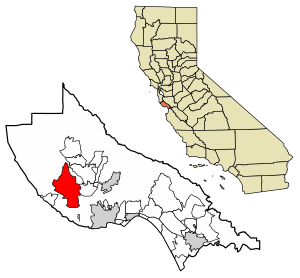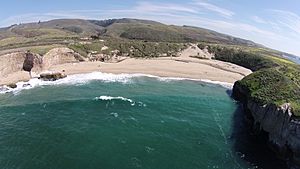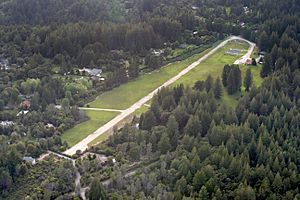Bonny Doon, California facts for kids
Quick facts for kids
Bonny Doon
|
|
|---|---|

Location of Bonny Doon in Santa Cruz County, California.
|
|
| Country | United States |
| State | California |
| County | Santa Cruz |
| Area | |
| • Total | 16.56 sq mi (42.90 km2) |
| • Land | 16.56 sq mi (42.90 km2) |
| • Water | 0.00 sq mi (0.00 km2) 0% |
| Elevation | 1,476 ft (450 m) |
| Population
(2020)
|
|
| • Total | 2,868 |
| • Density | 173.16/sq mi (66.86/km2) |
| Time zone | UTC-8 (Pacific (PST)) |
| • Summer (DST) | UTC-7 (PDT) |
| ZIP Code |
95060
|
| GNIS feature ID | 2582948 |
Bonny Doon is a special kind of community called a census-designated place in Santa Cruz County, California. It's located northwest of the city of Santa Cruz. This area is considered part of the southern San Francisco Bay Area or the northern Monterey Bay Area. In 2020, about 2,868 people lived in Bonny Doon.
Bonny Doon started in the 1850s as a place where people cut down trees for wood, known as a logging camp. The name "Bonny Doon" comes from a Scottish man named John Burns. In 1902, he named it after a line from a song by Robert Burns called "The Banks O' Doon". The song mentions "Ye banks and braes o' bonnie Doon...", referring to the Doon River in Scotland. People have found signs that Native Americans lived in this area for about 2,600 years!
Bonny Doon doesn't have a main city center or many shops. However, it has several wineries, including Bonny Doon Vineyard. You can also find a church, two fire stations, a lavender farm, and the Bonny Doon Ecological Reserve here. There's also an elementary school and a small private airport.
Contents
Bonny Doon's Location and Landscape
Bonny Doon covers an area of about 16.7 square miles (43.2 km²), all of it land. It sits at an elevation of about 1,476 feet (450 meters) above sea level.
The land in Bonny Doon slopes downwards. Higher up, you'll find redwood forests or maritime chaparral, which is a type of shrubland. As you go lower, the land turns into grasslands near the coast. On clear days, you can see the ocean from many parts of Bonny Doon.
The University of California, Santa Cruz is close by, which makes Bonny Doon a popular place for people who work there. It's also popular for those who work from home. Even though it's a bit far out, you can still get internet service like DSL and Cable Modem, and television. However, mobile phone service can be tricky because of the mountains and many trees.
Interesting Places and People
The famous science fiction writer, Robert A. Heinlein (1907–1988), and his wife Virginia lived in Bonny Doon. They designed and built their house here and lived in it from 1965 until just before he passed away.
The road leading to Bonny Doon from State Route 1 is called Bonny Doon Road. Along this road, you'll cross over a hidden conveyor belt. This belt used to carry limestone from a quarry (a place where stone is dug out) about 3 miles (5 km) east. The limestone went to the Cemex cement plant in Davenport. This plant, which opened in 1906, provided cement for big projects like the later parts of the Panama Canal. The plant is now closed.
Bonny Doon's Population
| Historical population | |||
|---|---|---|---|
| Census | Pop. | %± | |
| 2010 | 2,678 | — | |
| 2020 | 2,868 | 7.1% | |
| U.S. Decennial Census | |||
In 2010, Bonny Doon had 2,678 people. By 2020, the population grew to 2,868. This means there were about 160.5 people living in each square mile (62.0/km2). Most people in Bonny Doon live in houses they own.
The population is made up of people from different backgrounds. In 2010, about 92.4% of the people were White, 1.9% were Asian, and 0.6% were Native American. About 6.3% of the people were Hispanic or Latino.
Wildfires in Bonny Doon
Bonny Doon has experienced some large wildfires.
The Martin Fire (2008)
On June 11, 2008, a fire started at the Bonny Doon Ecological Reserve. This reserve has hiking trails and is a protected natural area. This fire, called the Martin Fire, burned about 520 acres (2.1 km2). It destroyed three homes and eight other buildings. About 1,500 people living in Bonny Doon had to leave their homes for safety. The Governor of California, Arnold Schwarzenegger, declared a special "state of emergency" for Santa Cruz County because of the fire. This fire cost over $5.4 million to put out.
The Lockheed Fire (2009)
Just over a year later, on August 12, 2009, another fire began in Bonny Doon. This fire started near the Lockheed facility. The Lockheed Fire was much larger, burning about 7,817 acres (31.6 km2). It destroyed 13 other buildings. More than 2,000 residents had to evacuate as the fire spread. This blaze cost over $26.6 million and took almost two weeks to be fully put out. The cause of this fire is still being investigated.
Images for kids
See also
 In Spanish: Bonny Doon para niños
In Spanish: Bonny Doon para niños





